Contract Law Analysis: Peter vs. Lee - HA2022 Business Law Report
VerifiedAdded on 2022/10/09
|7
|1226
|336
Report
AI Summary
This report analyzes a contract law case concerning a restraint of trade clause between Peter and Lee, who were dealers of imitation jewelry. The report uses the IRAC method to examine the issue of whether Peter can enforce a covenant against Lee. It outlines the legal rules surrounding restraint of trade clauses, including the common law doctrine and relevant legislation in Australia. The application section analyzes the specific conditions of the restraint clause, considering the time and area limitations. The report concludes that Peter cannot enforce the covenant due to the unreasonable area limit, which would contravene public policy. References to relevant legal cases and legislation are also included.
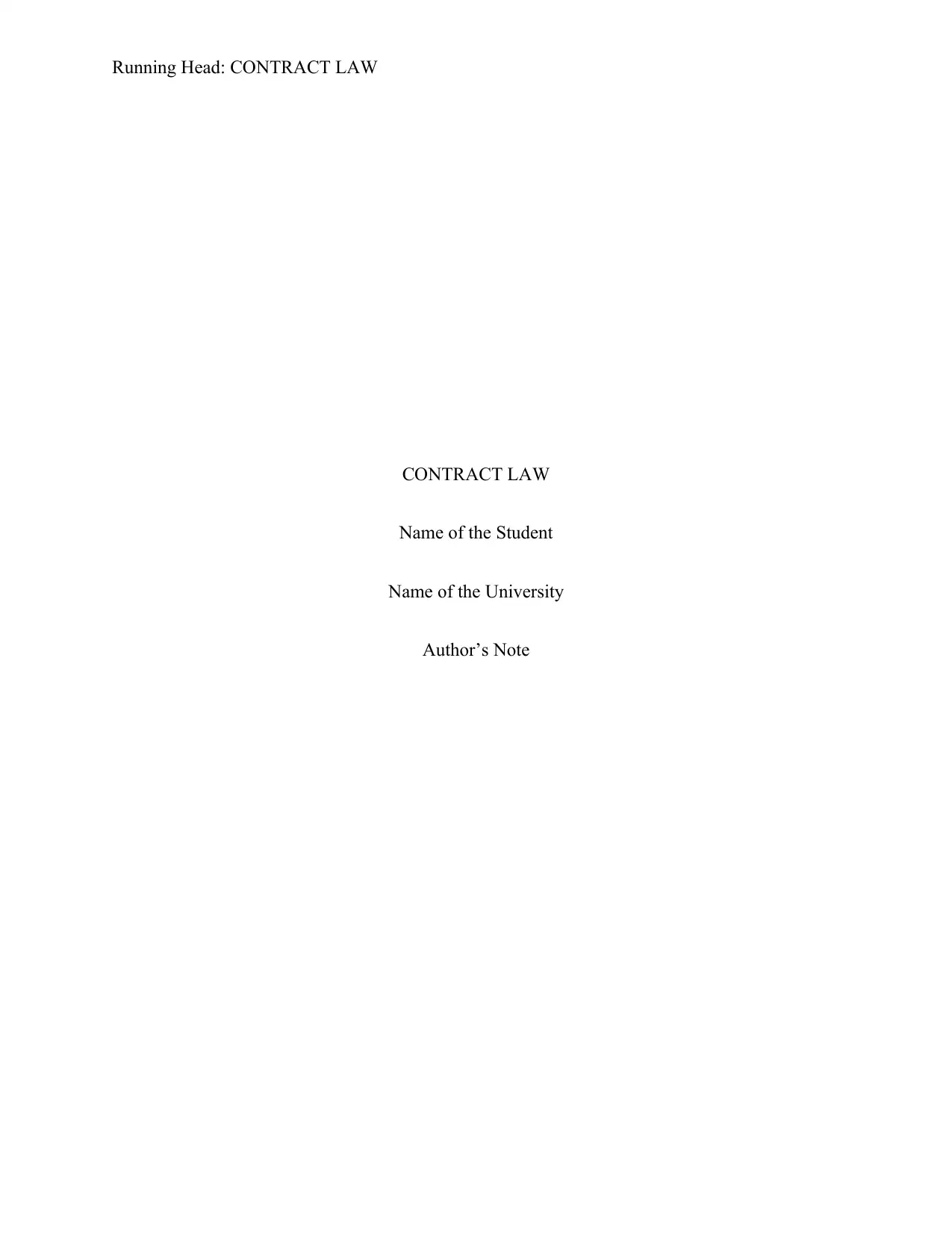
Running Head: CONTRACT LAW
CONTRACT LAW
Name of the Student
Name of the University
Author’s Note
CONTRACT LAW
Name of the Student
Name of the University
Author’s Note
Paraphrase This Document
Need a fresh take? Get an instant paraphrase of this document with our AI Paraphraser
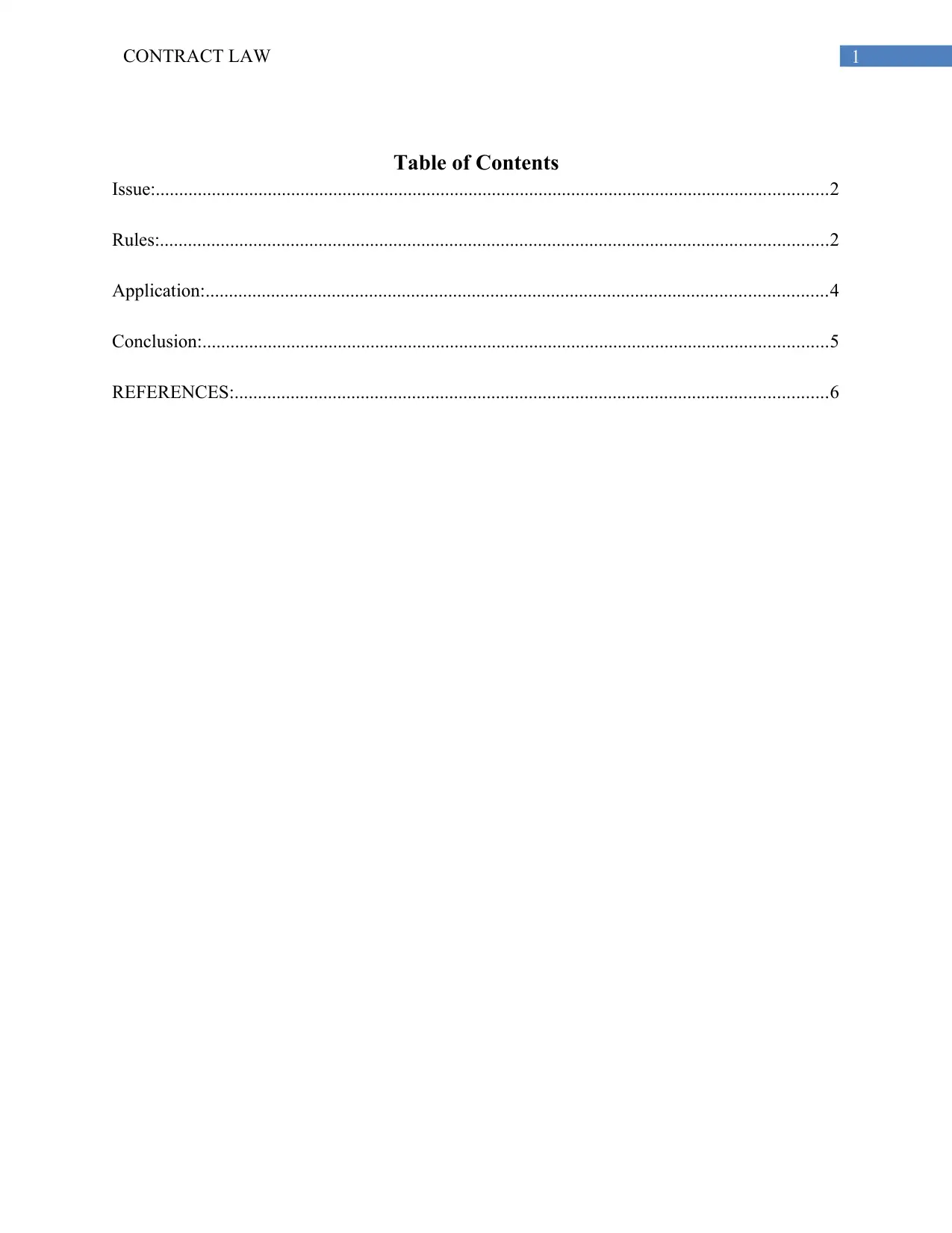
1CONTRACT LAW
Table of Contents
Issue:................................................................................................................................................2
Rules:...............................................................................................................................................2
Application:.....................................................................................................................................4
Conclusion:......................................................................................................................................5
REFERENCES:...............................................................................................................................6
Table of Contents
Issue:................................................................................................................................................2
Rules:...............................................................................................................................................2
Application:.....................................................................................................................................4
Conclusion:......................................................................................................................................5
REFERENCES:...............................................................................................................................6
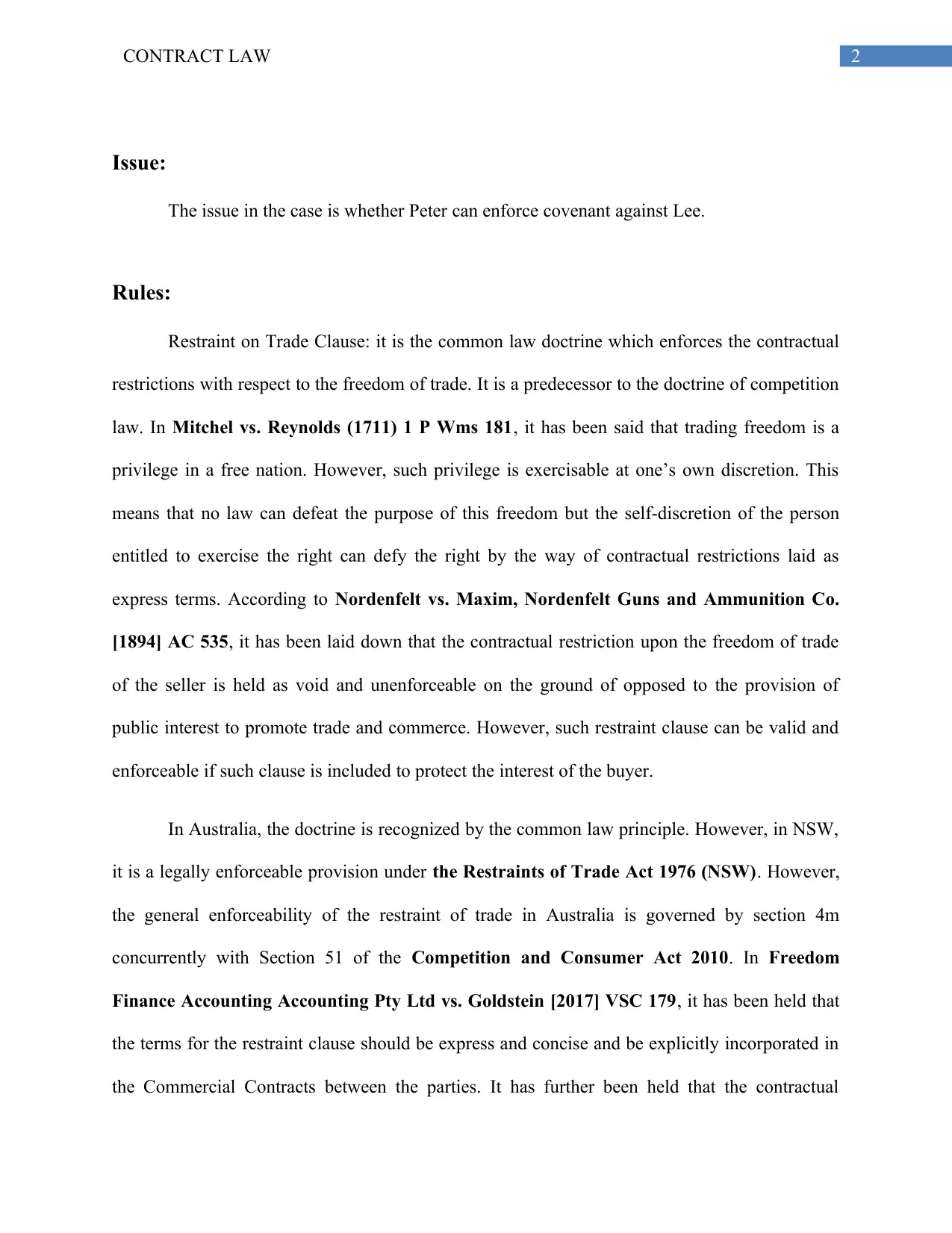
2CONTRACT LAW
Issue:
The issue in the case is whether Peter can enforce covenant against Lee.
Rules:
Restraint on Trade Clause: it is the common law doctrine which enforces the contractual
restrictions with respect to the freedom of trade. It is a predecessor to the doctrine of competition
law. In Mitchel vs. Reynolds (1711) 1 P Wms 181, it has been said that trading freedom is a
privilege in a free nation. However, such privilege is exercisable at one’s own discretion. This
means that no law can defeat the purpose of this freedom but the self-discretion of the person
entitled to exercise the right can defy the right by the way of contractual restrictions laid as
express terms. According to Nordenfelt vs. Maxim, Nordenfelt Guns and Ammunition Co.
[1894] AC 535, it has been laid down that the contractual restriction upon the freedom of trade
of the seller is held as void and unenforceable on the ground of opposed to the provision of
public interest to promote trade and commerce. However, such restraint clause can be valid and
enforceable if such clause is included to protect the interest of the buyer.
In Australia, the doctrine is recognized by the common law principle. However, in NSW,
it is a legally enforceable provision under the Restraints of Trade Act 1976 (NSW). However,
the general enforceability of the restraint of trade in Australia is governed by section 4m
concurrently with Section 51 of the Competition and Consumer Act 2010. In Freedom
Finance Accounting Accounting Pty Ltd vs. Goldstein [2017] VSC 179, it has been held that
the terms for the restraint clause should be express and concise and be explicitly incorporated in
the Commercial Contracts between the parties. It has further been held that the contractual
Issue:
The issue in the case is whether Peter can enforce covenant against Lee.
Rules:
Restraint on Trade Clause: it is the common law doctrine which enforces the contractual
restrictions with respect to the freedom of trade. It is a predecessor to the doctrine of competition
law. In Mitchel vs. Reynolds (1711) 1 P Wms 181, it has been said that trading freedom is a
privilege in a free nation. However, such privilege is exercisable at one’s own discretion. This
means that no law can defeat the purpose of this freedom but the self-discretion of the person
entitled to exercise the right can defy the right by the way of contractual restrictions laid as
express terms. According to Nordenfelt vs. Maxim, Nordenfelt Guns and Ammunition Co.
[1894] AC 535, it has been laid down that the contractual restriction upon the freedom of trade
of the seller is held as void and unenforceable on the ground of opposed to the provision of
public interest to promote trade and commerce. However, such restraint clause can be valid and
enforceable if such clause is included to protect the interest of the buyer.
In Australia, the doctrine is recognized by the common law principle. However, in NSW,
it is a legally enforceable provision under the Restraints of Trade Act 1976 (NSW). However,
the general enforceability of the restraint of trade in Australia is governed by section 4m
concurrently with Section 51 of the Competition and Consumer Act 2010. In Freedom
Finance Accounting Accounting Pty Ltd vs. Goldstein [2017] VSC 179, it has been held that
the terms for the restraint clause should be express and concise and be explicitly incorporated in
the Commercial Contracts between the parties. It has further been held that the contractual
⊘ This is a preview!⊘
Do you want full access?
Subscribe today to unlock all pages.

Trusted by 1+ million students worldwide
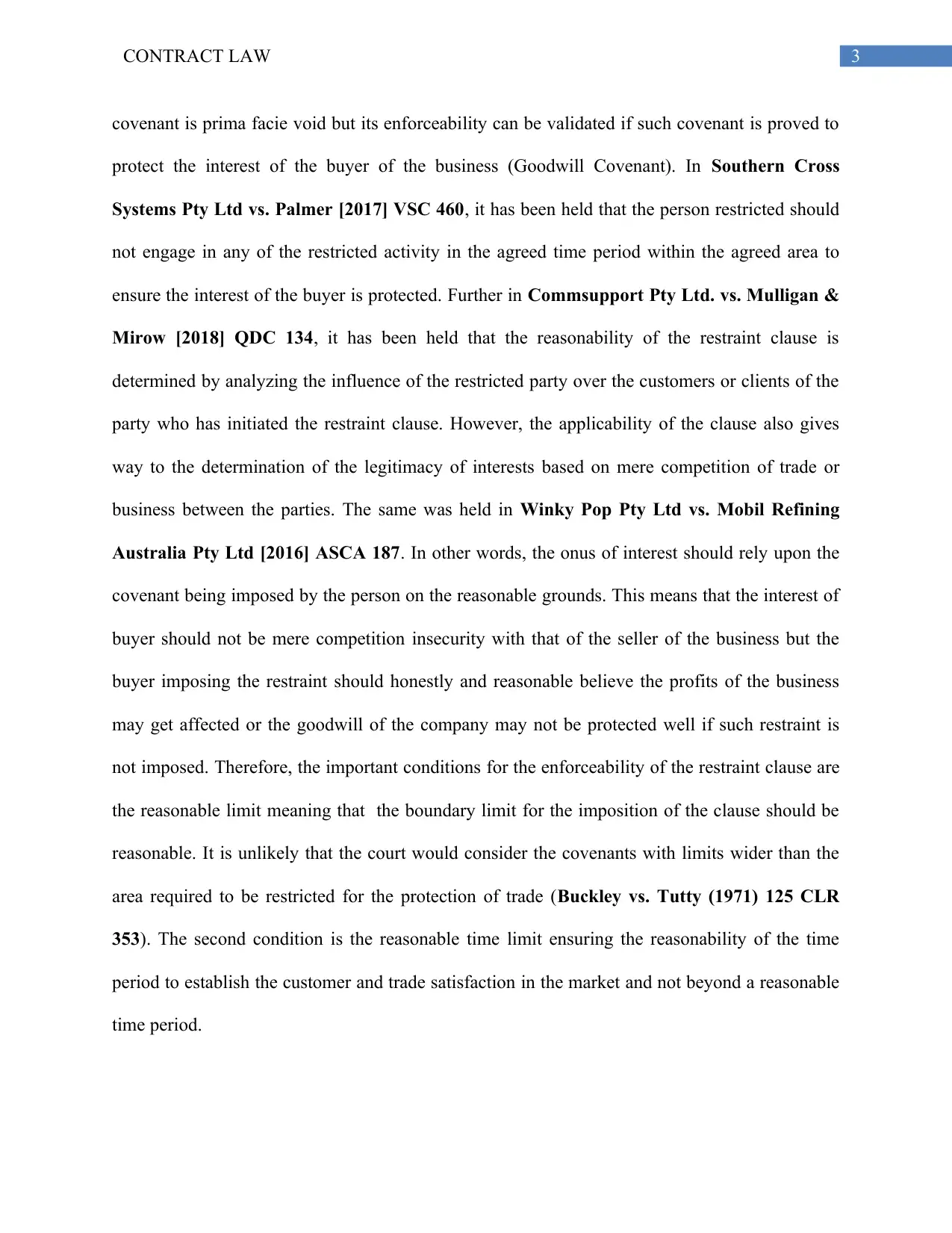
3CONTRACT LAW
covenant is prima facie void but its enforceability can be validated if such covenant is proved to
protect the interest of the buyer of the business (Goodwill Covenant). In Southern Cross
Systems Pty Ltd vs. Palmer [2017] VSC 460, it has been held that the person restricted should
not engage in any of the restricted activity in the agreed time period within the agreed area to
ensure the interest of the buyer is protected. Further in Commsupport Pty Ltd. vs. Mulligan &
Mirow [2018] QDC 134, it has been held that the reasonability of the restraint clause is
determined by analyzing the influence of the restricted party over the customers or clients of the
party who has initiated the restraint clause. However, the applicability of the clause also gives
way to the determination of the legitimacy of interests based on mere competition of trade or
business between the parties. The same was held in Winky Pop Pty Ltd vs. Mobil Refining
Australia Pty Ltd [2016] ASCA 187. In other words, the onus of interest should rely upon the
covenant being imposed by the person on the reasonable grounds. This means that the interest of
buyer should not be mere competition insecurity with that of the seller of the business but the
buyer imposing the restraint should honestly and reasonable believe the profits of the business
may get affected or the goodwill of the company may not be protected well if such restraint is
not imposed. Therefore, the important conditions for the enforceability of the restraint clause are
the reasonable limit meaning that the boundary limit for the imposition of the clause should be
reasonable. It is unlikely that the court would consider the covenants with limits wider than the
area required to be restricted for the protection of trade (Buckley vs. Tutty (1971) 125 CLR
353). The second condition is the reasonable time limit ensuring the reasonability of the time
period to establish the customer and trade satisfaction in the market and not beyond a reasonable
time period.
covenant is prima facie void but its enforceability can be validated if such covenant is proved to
protect the interest of the buyer of the business (Goodwill Covenant). In Southern Cross
Systems Pty Ltd vs. Palmer [2017] VSC 460, it has been held that the person restricted should
not engage in any of the restricted activity in the agreed time period within the agreed area to
ensure the interest of the buyer is protected. Further in Commsupport Pty Ltd. vs. Mulligan &
Mirow [2018] QDC 134, it has been held that the reasonability of the restraint clause is
determined by analyzing the influence of the restricted party over the customers or clients of the
party who has initiated the restraint clause. However, the applicability of the clause also gives
way to the determination of the legitimacy of interests based on mere competition of trade or
business between the parties. The same was held in Winky Pop Pty Ltd vs. Mobil Refining
Australia Pty Ltd [2016] ASCA 187. In other words, the onus of interest should rely upon the
covenant being imposed by the person on the reasonable grounds. This means that the interest of
buyer should not be mere competition insecurity with that of the seller of the business but the
buyer imposing the restraint should honestly and reasonable believe the profits of the business
may get affected or the goodwill of the company may not be protected well if such restraint is
not imposed. Therefore, the important conditions for the enforceability of the restraint clause are
the reasonable limit meaning that the boundary limit for the imposition of the clause should be
reasonable. It is unlikely that the court would consider the covenants with limits wider than the
area required to be restricted for the protection of trade (Buckley vs. Tutty (1971) 125 CLR
353). The second condition is the reasonable time limit ensuring the reasonability of the time
period to establish the customer and trade satisfaction in the market and not beyond a reasonable
time period.
Paraphrase This Document
Need a fresh take? Get an instant paraphrase of this document with our AI Paraphraser
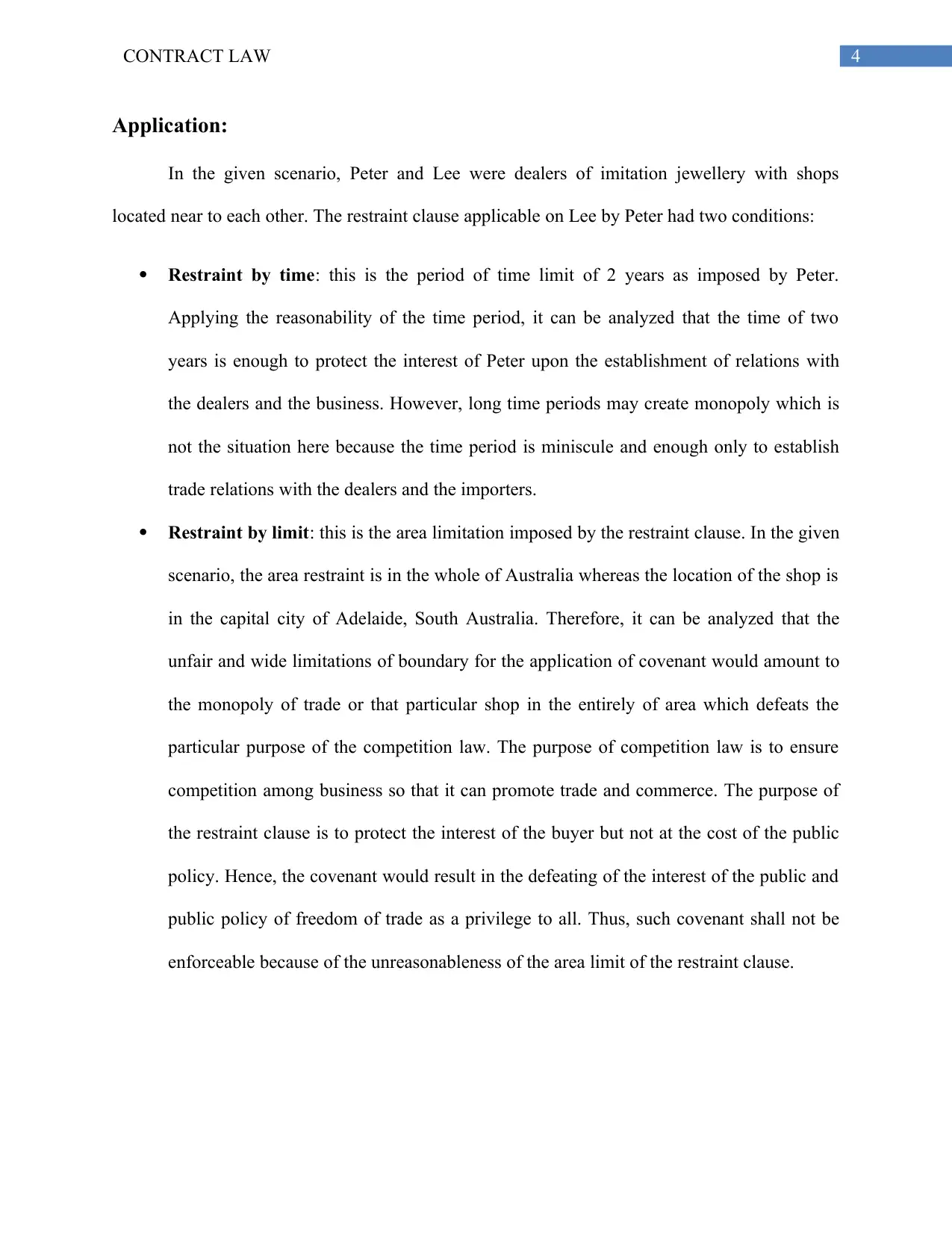
4CONTRACT LAW
Application:
In the given scenario, Peter and Lee were dealers of imitation jewellery with shops
located near to each other. The restraint clause applicable on Lee by Peter had two conditions:
Restraint by time: this is the period of time limit of 2 years as imposed by Peter.
Applying the reasonability of the time period, it can be analyzed that the time of two
years is enough to protect the interest of Peter upon the establishment of relations with
the dealers and the business. However, long time periods may create monopoly which is
not the situation here because the time period is miniscule and enough only to establish
trade relations with the dealers and the importers.
Restraint by limit: this is the area limitation imposed by the restraint clause. In the given
scenario, the area restraint is in the whole of Australia whereas the location of the shop is
in the capital city of Adelaide, South Australia. Therefore, it can be analyzed that the
unfair and wide limitations of boundary for the application of covenant would amount to
the monopoly of trade or that particular shop in the entirely of area which defeats the
particular purpose of the competition law. The purpose of competition law is to ensure
competition among business so that it can promote trade and commerce. The purpose of
the restraint clause is to protect the interest of the buyer but not at the cost of the public
policy. Hence, the covenant would result in the defeating of the interest of the public and
public policy of freedom of trade as a privilege to all. Thus, such covenant shall not be
enforceable because of the unreasonableness of the area limit of the restraint clause.
Application:
In the given scenario, Peter and Lee were dealers of imitation jewellery with shops
located near to each other. The restraint clause applicable on Lee by Peter had two conditions:
Restraint by time: this is the period of time limit of 2 years as imposed by Peter.
Applying the reasonability of the time period, it can be analyzed that the time of two
years is enough to protect the interest of Peter upon the establishment of relations with
the dealers and the business. However, long time periods may create monopoly which is
not the situation here because the time period is miniscule and enough only to establish
trade relations with the dealers and the importers.
Restraint by limit: this is the area limitation imposed by the restraint clause. In the given
scenario, the area restraint is in the whole of Australia whereas the location of the shop is
in the capital city of Adelaide, South Australia. Therefore, it can be analyzed that the
unfair and wide limitations of boundary for the application of covenant would amount to
the monopoly of trade or that particular shop in the entirely of area which defeats the
particular purpose of the competition law. The purpose of competition law is to ensure
competition among business so that it can promote trade and commerce. The purpose of
the restraint clause is to protect the interest of the buyer but not at the cost of the public
policy. Hence, the covenant would result in the defeating of the interest of the public and
public policy of freedom of trade as a privilege to all. Thus, such covenant shall not be
enforceable because of the unreasonableness of the area limit of the restraint clause.
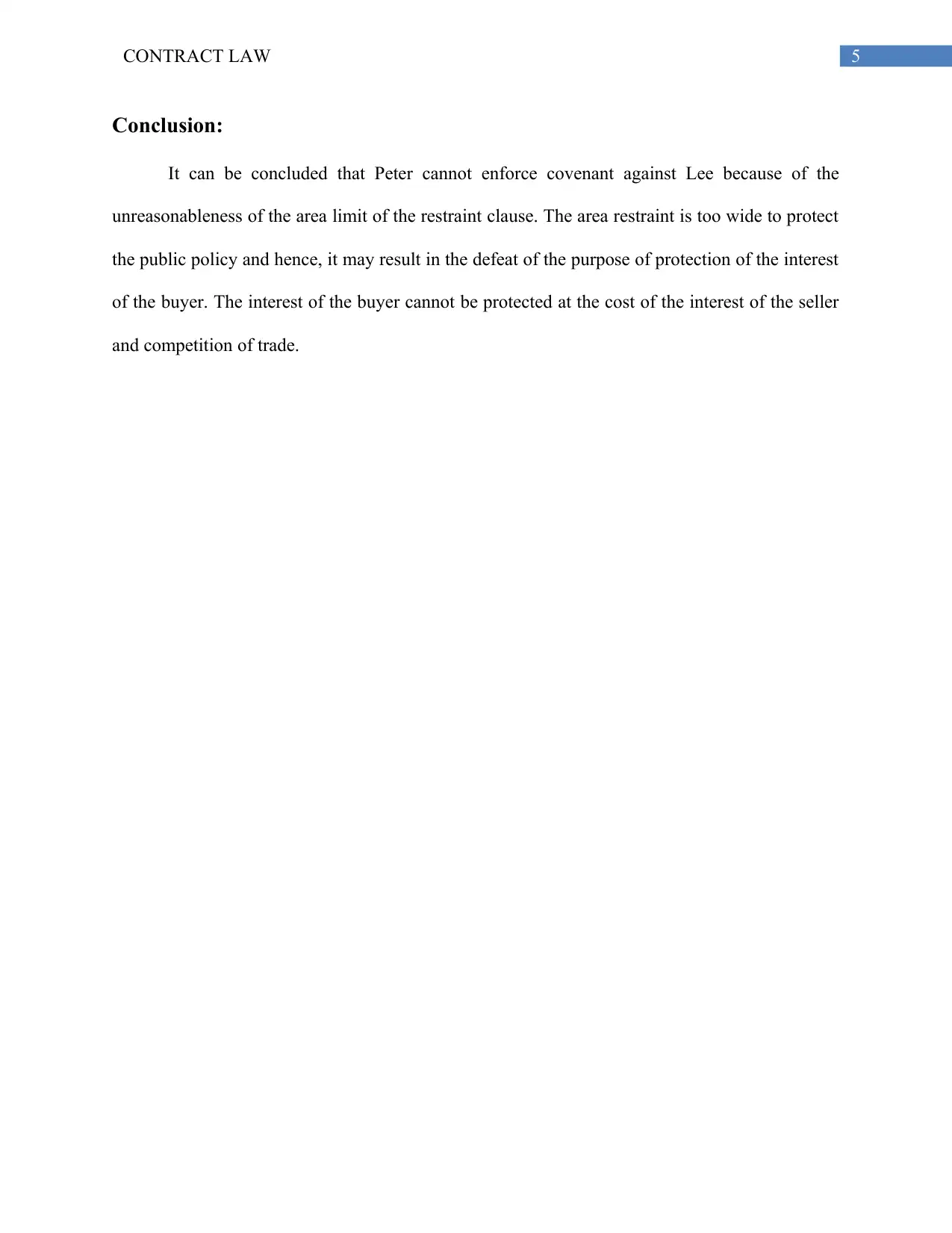
5CONTRACT LAW
Conclusion:
It can be concluded that Peter cannot enforce covenant against Lee because of the
unreasonableness of the area limit of the restraint clause. The area restraint is too wide to protect
the public policy and hence, it may result in the defeat of the purpose of protection of the interest
of the buyer. The interest of the buyer cannot be protected at the cost of the interest of the seller
and competition of trade.
Conclusion:
It can be concluded that Peter cannot enforce covenant against Lee because of the
unreasonableness of the area limit of the restraint clause. The area restraint is too wide to protect
the public policy and hence, it may result in the defeat of the purpose of protection of the interest
of the buyer. The interest of the buyer cannot be protected at the cost of the interest of the seller
and competition of trade.
⊘ This is a preview!⊘
Do you want full access?
Subscribe today to unlock all pages.

Trusted by 1+ million students worldwide
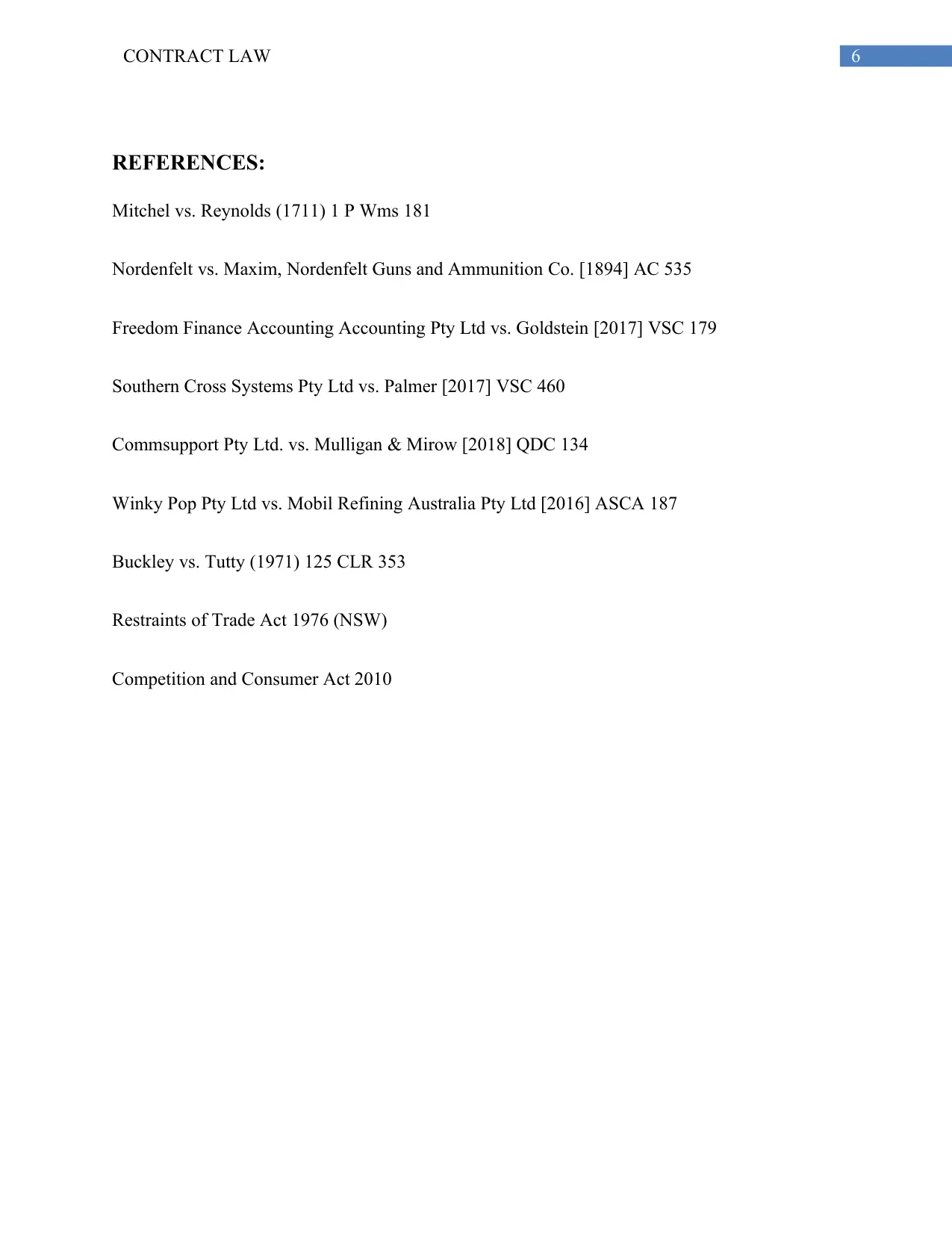
6CONTRACT LAW
REFERENCES:
Mitchel vs. Reynolds (1711) 1 P Wms 181
Nordenfelt vs. Maxim, Nordenfelt Guns and Ammunition Co. [1894] AC 535
Freedom Finance Accounting Accounting Pty Ltd vs. Goldstein [2017] VSC 179
Southern Cross Systems Pty Ltd vs. Palmer [2017] VSC 460
Commsupport Pty Ltd. vs. Mulligan & Mirow [2018] QDC 134
Winky Pop Pty Ltd vs. Mobil Refining Australia Pty Ltd [2016] ASCA 187
Buckley vs. Tutty (1971) 125 CLR 353
Restraints of Trade Act 1976 (NSW)
Competition and Consumer Act 2010
REFERENCES:
Mitchel vs. Reynolds (1711) 1 P Wms 181
Nordenfelt vs. Maxim, Nordenfelt Guns and Ammunition Co. [1894] AC 535
Freedom Finance Accounting Accounting Pty Ltd vs. Goldstein [2017] VSC 179
Southern Cross Systems Pty Ltd vs. Palmer [2017] VSC 460
Commsupport Pty Ltd. vs. Mulligan & Mirow [2018] QDC 134
Winky Pop Pty Ltd vs. Mobil Refining Australia Pty Ltd [2016] ASCA 187
Buckley vs. Tutty (1971) 125 CLR 353
Restraints of Trade Act 1976 (NSW)
Competition and Consumer Act 2010
1 out of 7
Related Documents
Your All-in-One AI-Powered Toolkit for Academic Success.
+13062052269
info@desklib.com
Available 24*7 on WhatsApp / Email
![[object Object]](/_next/static/media/star-bottom.7253800d.svg)
Unlock your academic potential
Copyright © 2020–2025 A2Z Services. All Rights Reserved. Developed and managed by ZUCOL.





